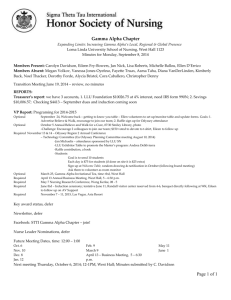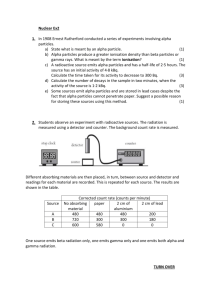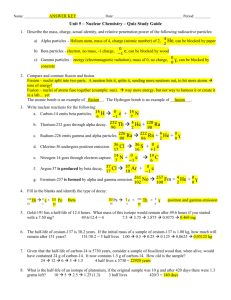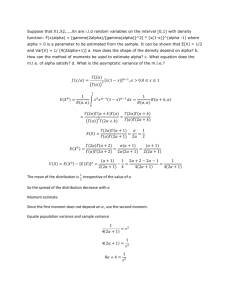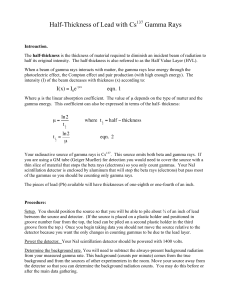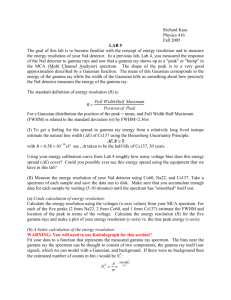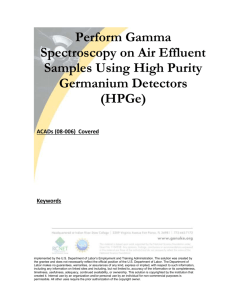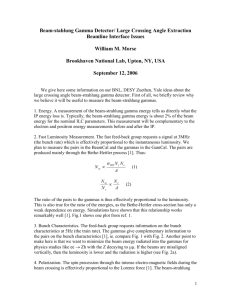Introductory Applied Physics Laboratory
advertisement
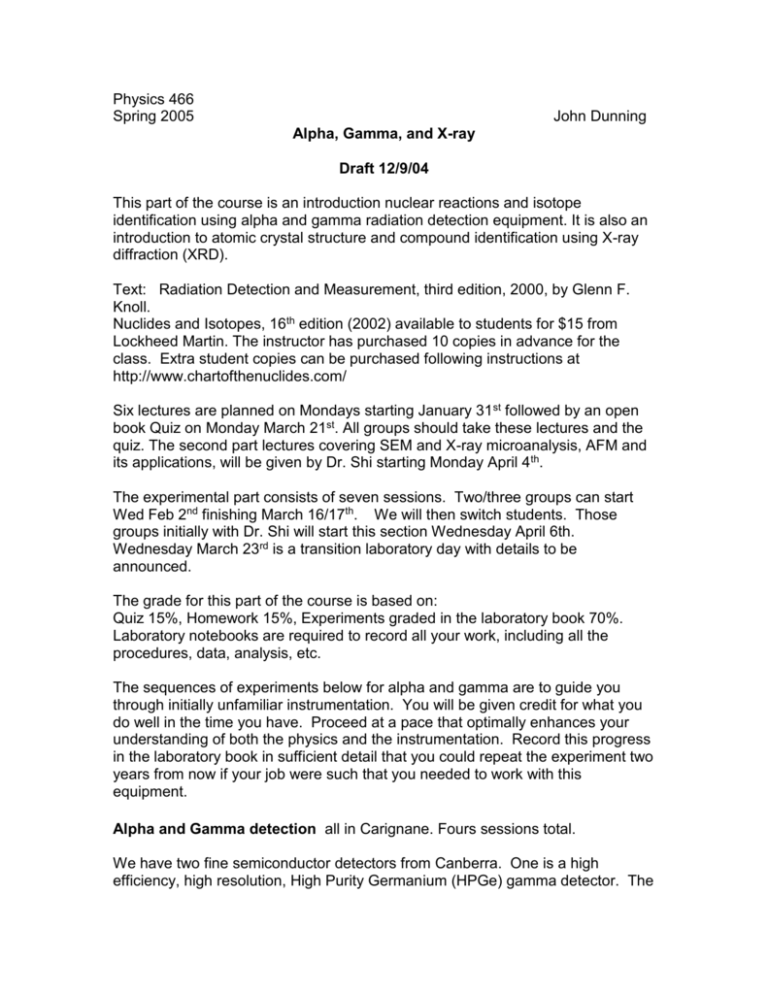
Physics 466 Spring 2005 John Dunning Alpha, Gamma, and X-ray Draft 12/9/04 This part of the course is an introduction nuclear reactions and isotope identification using alpha and gamma radiation detection equipment. It is also an introduction to atomic crystal structure and compound identification using X-ray diffraction (XRD). Text: Radiation Detection and Measurement, third edition, 2000, by Glenn F. Knoll. Nuclides and Isotopes, 16th edition (2002) available to students for $15 from Lockheed Martin. The instructor has purchased 10 copies in advance for the class. Extra student copies can be purchased following instructions at http://www.chartofthenuclides.com/ Six lectures are planned on Mondays starting January 31st followed by an open book Quiz on Monday March 21st. All groups should take these lectures and the quiz. The second part lectures covering SEM and X-ray microanalysis, AFM and its applications, will be given by Dr. Shi starting Monday April 4th. The experimental part consists of seven sessions. Two/three groups can start Wed Feb 2nd finishing March 16/17th. We will then switch students. Those groups initially with Dr. Shi will start this section Wednesday April 6th. Wednesday March 23rd is a transition laboratory day with details to be announced. The grade for this part of the course is based on: Quiz 15%, Homework 15%, Experiments graded in the laboratory book 70%. Laboratory notebooks are required to record all your work, including all the procedures, data, analysis, etc. The sequences of experiments below for alpha and gamma are to guide you through initially unfamiliar instrumentation. You will be given credit for what you do well in the time you have. Proceed at a pace that optimally enhances your understanding of both the physics and the instrumentation. Record this progress in the laboratory book in sufficient detail that you could repeat the experiment two years from now if your job were such that you needed to work with this equipment. Alpha and Gamma detection all in Carignane. Fours sessions total. We have two fine semiconductor detectors from Canberra. One is a high efficiency, high resolution, High Purity Germanium (HPGe) gamma detector. The other is a high resolution Passivated Implanted Planar Silicon (PIPS) surface barrier alpha detector. Both are supported by excellent Genie analysis software running under windows XP and by appropriate hardware/electronics. All groups do the first experiment which is an introduction to gamma detection and the Genie analysis software. Then the groups split. One group does one alpha and two gamma. The other group does two alpha and one gamma. First Session. Introduction to gamma spectroscopy. Neutron activation analysis of human hair and other samples. These sample were activated in the Washington State University Reactor in fall of 2002. They were counted at SSU a few days later for longer half life gammas using an HPGe detector on loan from Canberra. This detector had excellent resolution similar to the resolution of our present Canberra HPGE detector. Each group can pick a different spectrum and determine the elements present. Both nuclear lab computers have all spectra loaded. Second Session. All groups do the second gamma experiment at different times. This experiment aims to familiarize you with gamma calibration sources and to energy calibrate our detector. After calibration you can study the thorium series gammas using a gasoline lantern mantle as a source. Third session: All groups do the first alpha experiment at different times. In this experiment you energy calibrate our alpha detector using Am-241 and a pulser to determine zero. Then an energy absorption thickness gauge is demonstrated using thin Mylar sheets. Fourth session: One group does the second alpha experiment which consists of particulate air sampling and determining the origin of the alpha particles detected. The other group does the third gamma experiment, the hot luggage laboratory. Here you measure the U-238 series gammas and other photons from a depleted Uranium source. Then you use lead foil in an attempt to shield the source against detection. You also measure a natural uranium source to understand the additional gammas from U-235. XRD introduction three sessions all in The Keck laboratory, Salazar 2009b. First Session. Two exercises using interesting demonstration spectra help you to acquire initial familiarity with the powder diffraction file and the Jade analysis software. Sample preparation. Under supervision, each group prepares and runs two single compound (possibly multiple phase) samples from the chemistry stock room. Third session: Safety/machine protocol quiz. Run two suitably complex unknowns of different character. One should be a mineral. The other can be an interesting stamp or a metal.
